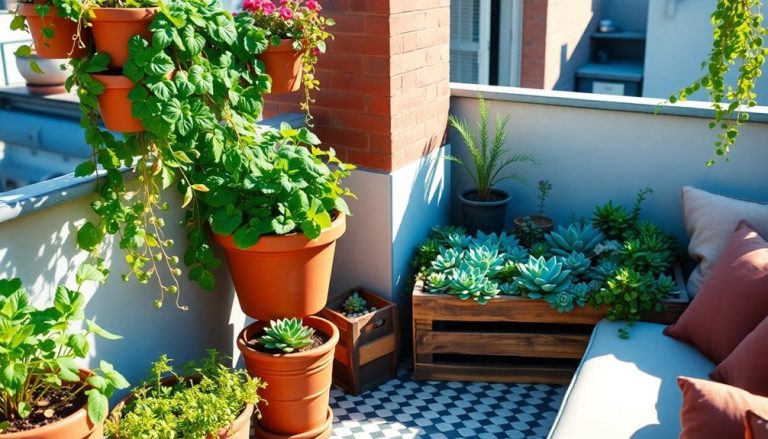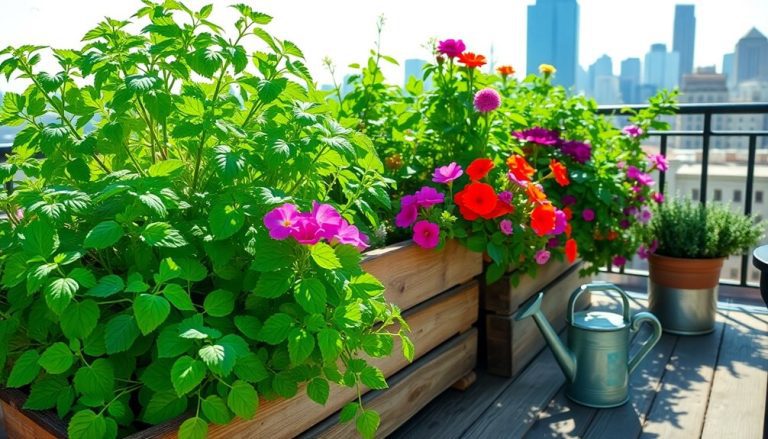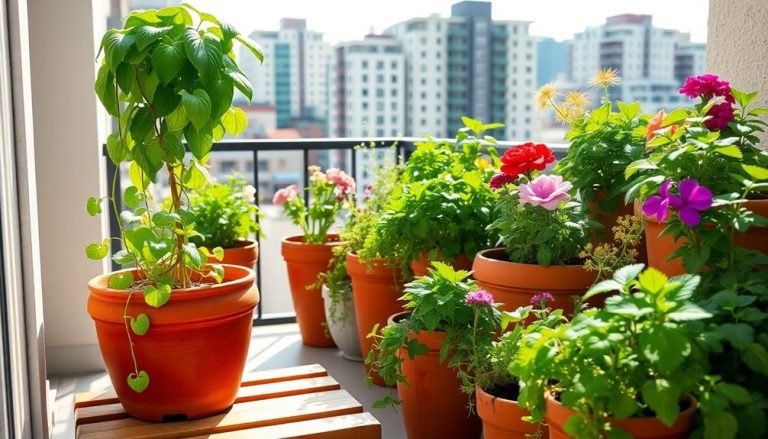For a stunning drought-resistant garden, consider three native plants: Agastache, Echinacea, and Rudbeckia. Agastache, or hyssop, thrives in dry conditions and attracts pollinators with its vibrant spikes of pink and purple flowers. Echinacea, known as coneflower, has deep roots that reach moisture, boasting colorful daisy-like blooms. Then there's Rudbeckia, or black-eyed Susan, with its bright yellow petals that add cheer to any garden. These plants not only require little maintenance but also support local wildlife. Keep exploring for more tips on creating a vibrant, sustainable garden.
Key Takeaways
- Agastache, with its vibrant spikes and drought tolerance, attracts pollinators and requires minimal maintenance once established.
- Echinacea, known for its deep roots, thrives in dry conditions and supports local ecosystems with its colorful flowers.
- Rudbeckia features sunny blooms, tolerates poor soil, and attracts beneficial insects, making it ideal for low-water gardens.
- These native plants enhance garden aesthetics while promoting biodiversity and reducing water consumption.
- Incorporating drought-resistant plants saves time and resources, contributing to sustainable gardening practices.
Agastache (Hyssop)
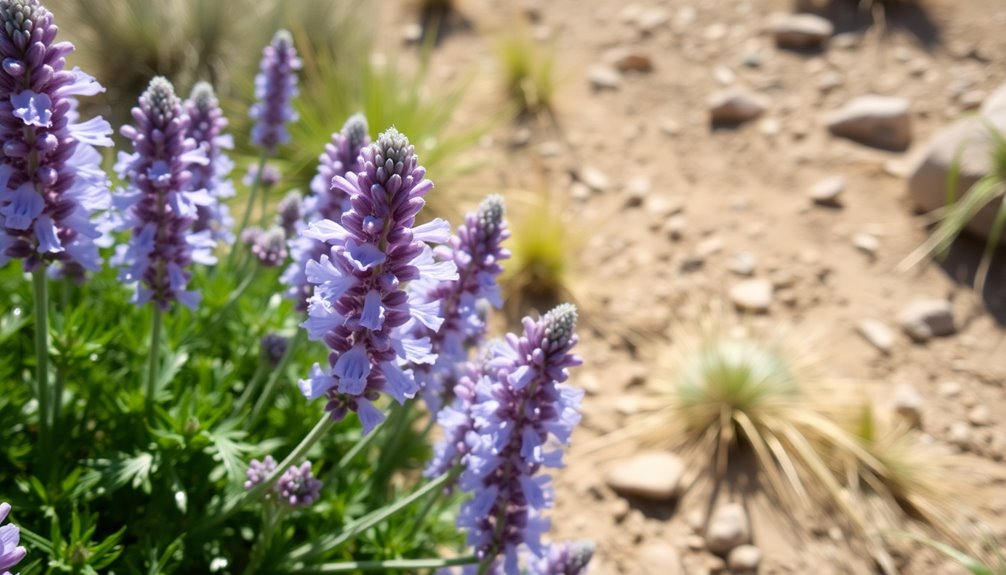
Agastache, commonly known as hyssop, thrives in drought-prone environments, making it an excellent choice for water-wise gardens. This hardy perennial not only withstands dry conditions but also attracts pollinators like bees and butterflies, enhancing your garden's biodiversity.
With its vibrant spikes of flowers, ranging from purples to pinks, Agastache adds a splash of color that can brighten any landscape. You'll appreciate that this plant requires minimal maintenance. Once established, it needs little watering and can survive in poor soil. Furthermore, these plants are often utilized for their natural insect-repelling properties, promoting a healthier garden ecosystem.
Plant it in full sun for the best results, and you'll see it flourish. The aromatic leaves also provide a delightful scent, which can deter some pests while inviting beneficial insects. Additionally, incorporating Agastache into your garden can reduce the need for organic pest control due to its natural pest-repelling properties.
When it comes to spacing, place your Agastache about 18 to 24 inches apart to allow for airflow and growth. As summer heat sets in, you'll notice the resilience of this plant; it remains lush and vibrant even when other plants struggle.
Plus, with its ability to self-seed, you might find new plants popping up in your garden, offering a beautiful surprise each year. Choose Agastache, and enjoy a stunning, low-maintenance addition to your drought-resistant garden.
Echinacea (Coneflower)
When summer rolls around, Echinacea, or coneflower, stands out as a resilient choice for drought-resistant gardens. This stunning perennial not only thrives in dry conditions but also attracts pollinators, making it a fantastic addition to your landscape.
Here's why you should consider incorporating Echinacea into your garden:
- Drought-Tolerant: Echinacea's deep roots enable it to access moisture from the soil, allowing it to withstand prolonged dry spells effectively. Additionally, using garden pest traps can help protect your Echinacea from harmful insects that may disrupt its growth.
- Attractive Blooms: Its vibrant, daisy-like flowers in shades of purple, pink, and white add a splash of color to your garden, enhancing visual appeal.
- Pollinator-Friendly: Bees, butterflies, and other beneficial insects flock to Echinacea, supporting local ecosystems and promoting biodiversity.
- Low Maintenance: Once established, Echinacea requires minimal care, making it perfect for busy gardeners or those new to gardening.
- Additionally, Echinacea pairs well with other drought-tolerant plants, creating a harmonious and sustainable garden environment.
Rudbeckia (Black-eyed Susan)
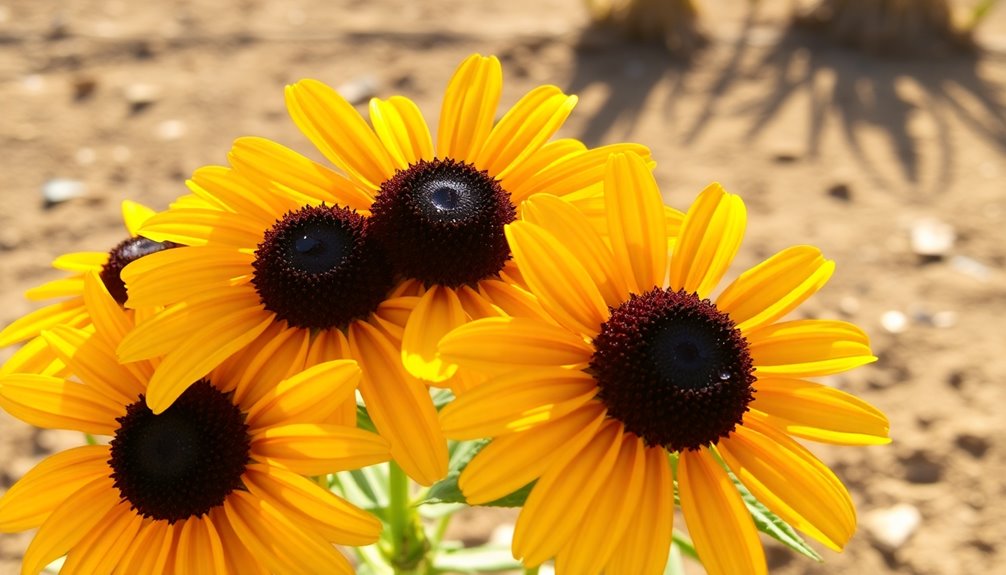
If you're looking to complement Echinacea in your drought-resistant garden, consider Rudbeckia, commonly known as Black-eyed Susan. This vibrant perennial brings sunny yellow blooms that brighten any landscape while thriving in low-water conditions. They're perfect for adding a pop of color alongside your coneflowers.
Rudbeckia is not only beautiful but also highly adaptable. It tolerates poor soil and heat, making it an excellent choice for those tough spots in your garden. Plus, these flowers attract pollinators like bees and butterflies, enhancing your garden's ecosystem. Using essential gardening tools can help you maintain your garden with ease.
Here's a quick overview of Rudbeckia's features:
| Feature | Details |
|---|---|
| Bloom Time | Summer to early fall |
| Sun Requirements | Full sun (6+ hours/day) |
| Water Needs | Low once established |
| Height | 2 to 3 feet tall |
Planting Rudbeckia alongside Echinacea not only creates a stunning visual contrast but also supports a drought-tolerant environment. With minimal care, you'll enjoy a flourishing garden filled with life and color. So, go ahead and include Black-eyed Susan in your landscape!
Frequently Asked Questions
How Do I Prepare My Soil for Drought-Resistant Plants?
To prepare your soil for drought-resistant plants, start by testing its pH and nutrients. Amend it with organic matter like compost, improve drainage, and ensure it retains moisture without becoming waterlogged. You're setting up a thriving environment!
What Are the Best Companion Plants for Drought-Tolerant Gardens?
Did you know that companion planting can boost yields by up to 20%? For drought-tolerant gardens, consider pairing lavender with sage or yarrow with echinacea. These combinations thrive together while conserving water and enhancing growth.
How Often Should I Water Drought-Resistant Plants?
You should water drought-resistant plants deeply but infrequently, typically every two to three weeks. Monitor rainfall and adjust as needed, ensuring the soil dries out between watering sessions to encourage strong root development.
Can I Grow Native Plants in Containers?
Yes, you can grow native plants in containers! Just choose the right size pot, use well-draining soil, and ensure they receive adequate sunlight. Container gardening allows you to enjoy their beauty wherever you like.
What Pests Should I Watch Out for With These Plants?
You'll feel like a pest magnet! Watch out for aphids, spider mites, and mealybugs. They'll sneak in like unwanted guests. Keep an eye out, and you'll keep your plants thriving and pest-free. You got this!
Conclusion
By incorporating Agastache, Echinacea, and Rudbeckia into your garden, you're not just planting flowers; you're creating a resilient oasis that thrives even in tough times. Much like a phoenix rising from the ashes, these native plants will flourish with minimal water, turning your garden into a vibrant refuge. So go ahead—embrace their beauty and strength, and watch your garden transform into a drought-resistant paradise that stands tall against the elements.


